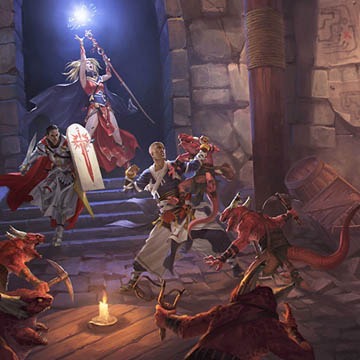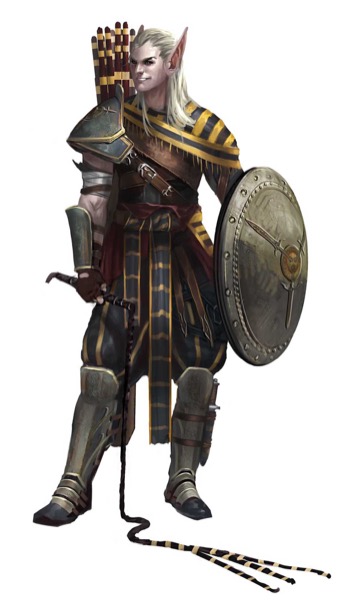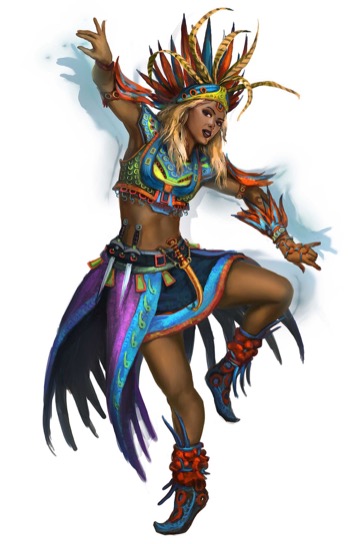The Second Edition of the Pathfinder Roleplaying Game is set to launch on August 1st, and in anticipation, we thought it was time to take a look at the game and give you a sense of what you can expect from the new version of the rules! Starting with this blog and continuing every week until release, we are going to be looking at different aspects of the game, from a broad overview to some of the finer details of character generation and adventure design. Taken together, these blogs should give you a head-start on learning the game and bringing it to your table!
What is Pathfinder all about?
At its heart, Pathfinder Second Edition is the same type of game as first edition. You take on the role of a sword & sorcery adventurer of your own design, going on daring adventures for a chance at fame and fortune. One player takes on the role of Game Master, helping to adjudicate the actions of player characters, nonplayer characters, and monsters, weaving all of them together to form a compelling story—one that everyone at the table helped to create!
Of course, as a game, Pathfinder is a lot more than just telling stories. It is a system of rules that defines how the world works, and for Second Edition we wanted to make sure that this game “engine” was easy to understand and interpret, both for players and Game Masters! And while we made sure that creating and advancing your character was a clean and intuitive as it could be, we also ensured that the game allowed your choices—your vision for your character—to truly matter. The decisions you make in Pathfinder define your character, expressed not just in the story but in the rules as well.
Core Mechanic
Pathfinder is a narrative roleplaying game, meaning that you describe what your character is attempting to do while the Game Master describes how the story and world unfolds around you. Whenever there is doubt or uncertainty in actions, you will be called upon to make a check, which requires you to roll a d20 and add a modifier based on your character’s proficiency at that particular challenge. These checks come in many forms, from swinging a sword to climbing a cliff to dodging a roaring fireball. The result of your check, as interpreted by the GM, determines whether or not you succeed at your task, and might even decide whether or not your character survives!
In Pathfinder Second Edition, proficiency determines nearly every important statistic used by your character during play. How skilled are you with a longbow? How good are you at Stealth? What is your aptitude for casting illusion magic? All of these statistics, and many more, are defined by your proficiency in the statistic.
Proficiency is gained through the choices you make in building your character. If you are untrained, you get no bonus at all, but you can still add a modifier from a relevant ability score to represent your raw talent. If you are trained, you add your level plus 2, along with any other relevant modifiers. If you are an expert, you add 4 instead. Masters add 6, and characters with legendary proficiency add 8. This basic formula applies to nearly everything in Pathfinder Second Edition, making it easy for you to see where you stand and understand what your chances are at overcoming the challenges the game puts in front of you.
Facing Danger
The world of Pathfinder is a dangerous place. Vampires lurk in forgotten tombs, trolls prowl in the mountains, and deadly dragons await atop mounds of priceless treasure. These threats—and many more—await your character as they explore the story, and more often than not, such encounters will end with a thrilling combat.
Combat in Pathfinder is much more structured than the freeform narrative play of the rest of the game. During combat, participants take turns, during which the number of things that can be accomplished is limited. On your turn, your character will get to take three actions. Many of these will be what are called basic actions, like moving, drawing a weapon, opening a door, or making an attack. Some might be special actions that only your character can take, based on the choices you made during character creation. Casting spells, performing amazing martial stunts, or utilizing special class features like rage are all examples of special actions.
Just because your turn is over does not mean that you do not have an opportunity to participate in the combat. Some characters can take special reactions that allow them to interrupt the flow of play on other characters’ turns. You might dodge an incoming attack, block with your shield, or even attempt to counter an enemy’s spell. Each character can only take one reaction between turns though, so you have to make it count!
Combat continues until one side is defeated, gives up, or retreats, but these deadly encounters are just one way that you might resolve conflict. You might use skills or magic to sneak past foes, or you could try to talk your way out of a fight, relying on guile and charm to win the day. Ultimately, the way you approach danger in Pathfinder is up to you, and your chance at success depends on the choices you make for your character!
Creating Your Story
Pathfinder Second Edition empowers you to tell your own story, no matter what side of the table you occupy. Players have a wide variety of choices in making their character, giving them the tools to bring their idea to life. Your choice of ancestry, background, and class define the major parts of your character, but they are just the beginning. Your choice of skills, feats, and gear say a lot about the player character you are portraying and as you gain power, the new choices you get to make speak to your hero’s journey. You can come up with a plan for your character’s growth, or you can let their adventures influence your decisions. It’s up to you!
Taking on the role of Game Master brings a whole different kind of flexibility to your role at the table. As GM, you get to shape the overall narrative, defining the actions of villains, monsters, and all of the nonplayer characters that make up the world. You provide the adversaries that the PCs must face if they hope to succeed, and your narrative forms the backdrop that allows the characters to grow and triumph. Pathfinder provides a wide range of tools to help you in this vital task, from guidelines on how to build balanced encounters to narrative advice, and guidance on how to create a welcoming play environment. Within the pages of the Core Rulebook you will also find a wealth of treasure to award to your PCs when they succeed and a bunch of devious traps to guard the treasure. Most importantly, the Bestiary contains over 400 monsters waiting to face off against your PCs, from shambling undead to fiendish demons.
What's Next
In the coming weeks, we are going to be looking at various aspects of Pathfinder Second Edition to give you a better idea about how each part of the game works. Next week, we are going to go over the steps you take when making and leveling up a character, but make sure to come back every week as we take a deep look at the new combat system, explore creating your own adventures, and provide a bunch of tips and tricks for using Pathfinder to tell your stories!
Jason Bulmahn
Director of Game Design
A First Look at Pathfinder Second Edition
Monday, June 24, 2019









